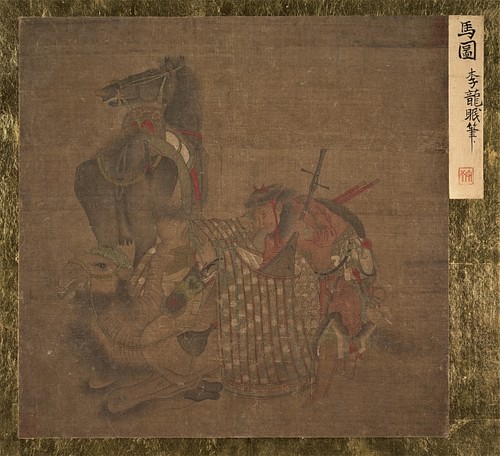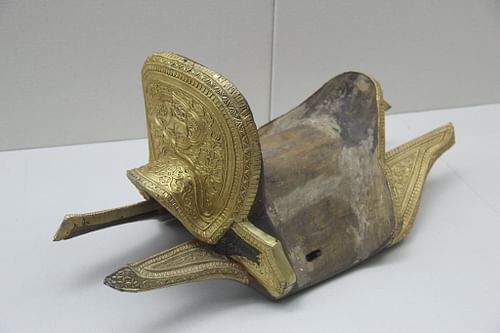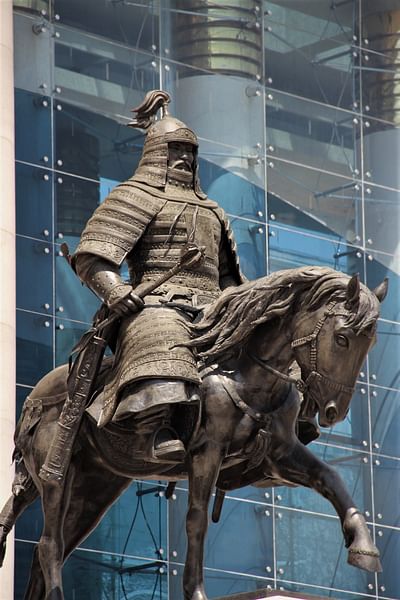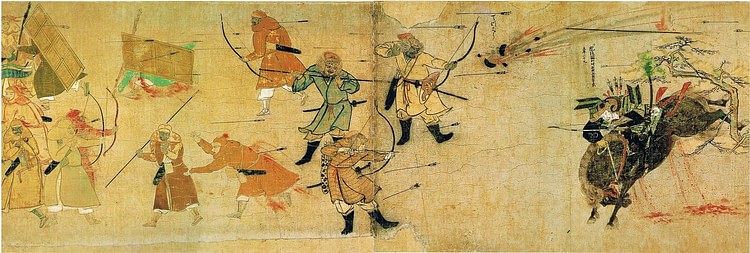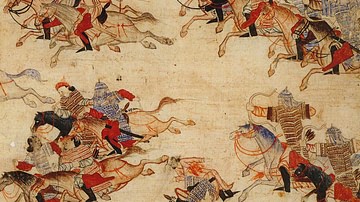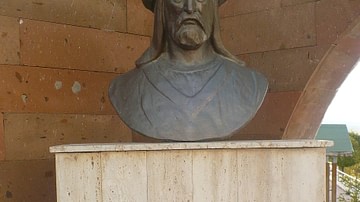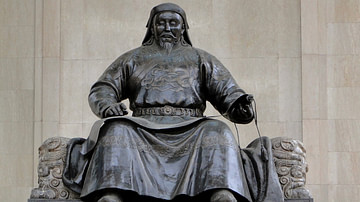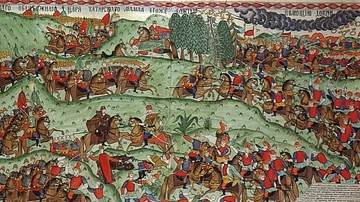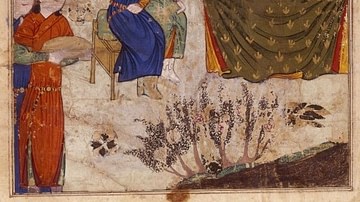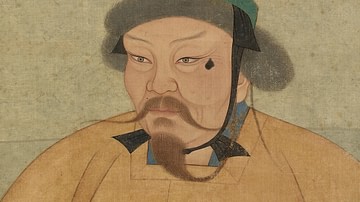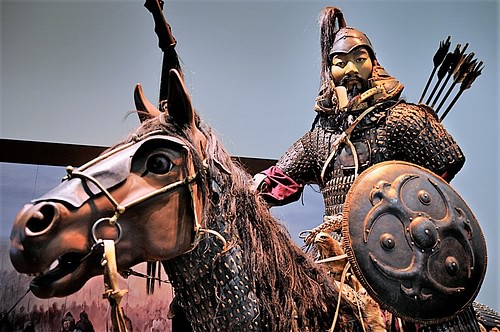
The Mongols conquered vast swathes of Asia in the 13th and 14th century CE thanks to their fast light cavalry and excellent bowmen, but another significant contribution to their success was the adoption of their enemies' tactics and technology that allowed them to defeat established military powers in China, Persia, and Eastern Europe. Adapting to different challenges and terrain, the Mongols became adept at both siege and naval warfare, very different pursuits from their nomadic origins on the Asian steppe. In addition, diplomacy, espionage, and terror were used in equal measure to win many a battle before it had even begun. Ultimately, the Mongols would establish the largest empire the world had ever seen, and their ruthlessness in battle would cast a long shadow of fear over those they conquered with generals earning fearsome nicknames such as the 'hounds of war' and their soldiers being labelled 'the devil's horsemen.'
A State for War
One of the main sources of legitimacy for a Mongol tribal leader was his ability to successfully conduct warfare and acquire booty for his followers. Under Genghis Khan (r. 1206-1227 CE), the founder of the Mongol Empire (1206-1368 CE), the Mongol people were thus reorganised to specifically gear the state for perpetual warfare. 98 units known as minghan or 'thousands' were created (and then later expanded) which were tribal units expected to provide the army with a levy of 1,000 men. The khan also had his own personal bodyguard of 10,000 men, the kesikten, which was the elite standing army of the Mongols and which trained commanders for the other divisions. A third source of troops was the armies raised from allies and conquered states, these outnumbered the Mongol contingents in the campaigns in China and Persia. Later, when Kublai Khan (r. 1260-1294 CE) established the Yuan dynasty in China (1271-1368 CE), Mongol armies there were composed entirely of professional soldiers.
Mongol leaders ensured loyalty and increased their chances of success by promoting commanders based on merit rather than the use of clan seniority as had been the case before Genghis. Motivation was high because booty was shared equally, and there was even a dedicated body, the jarqu, which ensured booty was distributed correctly (for example, horses, slaves, precious metals, textiles, high-quality manufactured goods, and even food). Commanders could expect to receive both booty and land or tribute from conquered peoples. Ordinary soldiers could expect rewards, too, some compensation for their conscription, which any Mongol male from 14 to 60 years old was liable for.
At the same time as being generous with rewards, Genghis insisted on discipline and any soldier or commander who disobeyed orders was severely punished, lashings being the commonest method. An ordinary soldier could expect nothing less than the death penalty for desertion, retreating when not ordered to, or sleeping when on sentry duty. Nevertheless, the khan did give his commanders great autonomy on the field of combat, and this flexibility usually reaped rewards.
Planning and logistics were another carefully considered area, best seen in the complex campaigns in southern Russia and Eastern Europe of 1237 to 1242 CE when multiple Mongol armies engaged their individual targets and then regrouped at predetermined times and locations. A significant help in knowing where both allies and enemies were at any one time was the excellent Mongol messenger service, the yam, with its series of posts stocked with supplies and fresh horses. Smoke signals were also used as a means of communication between separated divisions. Another strength was the willingness to recruit non-Mongols. Uyghur Turks were enrolled in large numbers, as were Kurds and Khitans, while Koreans and Chinese were a significant part of the forces which invaded Japan in 1274 and 1281 CE. In short, then, the Mongols were made perpetually ready for war.
Training & Weapons
Warriors were prepared from childhood thanks to the Mongol tradition of having both young boys and girls participate in competitions of athletics, horse racing, wrestling, hunting, and archery. The Mongol warriors - mostly men but also sometimes women, too - were, then, already proficient at using battle axes, lances (often hooked to pull enemy riders from their mounts), spears, daggers, long knives, and sometimes swords which were typically short, light, and with a single cutting edge.
The Mongol weapon of choice was the composite bow, which could fire arrows double the distance of those in competing armies. In addition, warriors could shoot with accuracy while riding their horses at speed thanks to stirrups and wooden saddles with a high back and front which gave better stability so that an archer could turn and fire in any direction, including behind him. The composite bow was made of multiple layers of wood, bamboo or horn, making it both strong and flexible. As it was strung against its natural curve, the Mongol bow required some strength to draw but then fired arrows with a high degree of accuracy and penetration.
Arrowheads tended to be made from bone and, much more rarely, metal while shafts were made from wood, reed, or a combination of both, and fletchings from bird feathers. Arrow designs varied depending on their purpose - to wound at close range, fire at distant targets, carry poison, penetrate armour, or even whistle as a signal to other units. A typical mounted archer carried two or three bows and around 30 light and 30 heavier arrows in a quiver. Additional standard equipment included a horsehair lasso, a coil of rope, an axe, a file for making arrowheads, a sewing repair kit, a leather bag for food and to use as a float when crossing rivers, two leather bottles for liquids, and a cooking pot. Men slept in light versions of the classic yurt tent, one carried for every ten riders.
To the Mongols, horses were everything - a means to travel, a source of wealth and a way to measure it, food, and the source of their great mobility in warfare. Mongol horses were relatively small but sturdy beasts with dense hair and capable of enduring hardships. They had excellent stamina, which allowed cavalry to travel a very impressive 95-120 kilometres (60-75 miles) in a single day. The Mongols had both light and heavy cavalry, and each rider typically had up to 16 spare horses giving them a very long range of manoeuvre. On the battlefield, cavalry units responded to orders conveyed by gongs and drums (although curiously the very first attack was always conducted in silence). Horses could also be a source of nourishment while on campaign by letting blood from the neck. This would have supplemented dry rations like cheese curd and cured meat.
Armour
Mongol armour was light so as to not impede the speed of cavalry riders, but if worn, it was typically made of thick quilted felt or leather. Sometimes this soft armour, like the heavy coats many riders wore, could be strengthened by adding strips of metal, bone or hardened/lacquered leather but plate armour and chain mail were rare, although that captured from the enemy was sometimes worn. Learning from the Chinese, a silk undershirt might be worn as this had the handy consequence of wrapping around the arrowhead if one was struck, protecting the wound and making the arrow easier to withdraw.
The head was protected by either an iron or hardened leather helmet, sometimes with a neck guard and a central top spike or ball and plume. An alternative was the traditional Mongol fur hat with side flaps and upturned brim. Shields, if used, were typically only carried by infantrymen and were most commonly small, circular, and made of wicker or hardened leather. Horses were sometimes given armour, made from the same materials mentioned above. Plate armour was restricted to the horse's head but, otherwise, some mounts were completely covered with padded armour.
Tactics
Planning
One of the important reasons for the Mongol success in warfare was their preparation before even meeting the enemy. Spies in the form of travelling merchants or priests and defectors gathered intelligence on the enemy's strengths and weaknesses and revealed if there were any dissenters either within or between the enemy's allies who could be a potential aid to the Mongol cause. A great meeting or kurultai of Mongol leaders was held before a large campaign to discuss plans and strategies in detail. Once in the field, intelligence continued to be gathered and scouts operated up to 110 kilometres (70 miles) ahead and either side of dispersed Mongol columns to ensure they were not caught off-guard or fell foul of an ambush.
Manoeuvres
Mongol armies moved extremely quickly and attempted to outmanoeuvre their opponents using speed and coordination. The aim was to only engage the enemy when absolutely necessary and to commit large numbers only when a specific weak spot had been identified. This strategy was designed to give maximum results for minimal losses. Cavalry units of around 1,000 men (a minghan) were subdivided into units of 100 (a jagun), which was in turn divided into units of 10 (an arban).
A Mongol army in the field was typically divided into wings operating either side of a central force and a vanguard. Indeed, even a Mongol camp was divided according to these groupings. A Mongol cavalry army rarely exceeded 10,000 riders in any one place at one time, even the very largest campaigns such as in Europe probably contained only three such 10,000-men divisions (tumens), the rest of the army, perhaps triple the size of the Mongol cavalry in some cases, was made of allies who conducted warfare according to their own traditions. The Mongols were usually outnumbered by their enemies in field battles but overcame this disadvantage by superior speed and tactics. A disadvantage of fielding relatively small armies was the difficulty in replacing casualties. Often vanquished troops were enlisted but in such campaigns as Eastern Europe, where loyalties were stronger, it did sometimes necessitate a withdrawal until reinforcements could arrive from Mongolia.
A classic Mongol strategy was to attack with a small force and then feign a retreat which only led the enemy back to a larger Mongol force. Another favoured manoeuvre was the tulughma, that is to attack with a central body of cavalry - heavy cavalry in the front lines and lighter units behind, who then moved through gaps in the front lines - and while these moved forward as one, cavalry units moved on the wings to envelop the enemy forces. The tactic was a smaller-scale version of the nerge, the Mongol hunting strategy used over vast areas of steppe to corner wild game. Sometimes these wings were very extended and so allowed the Mongols to entirely surround an opposing army. A reserve of heavy cavalry then moved in for the kill and any escaping enemy troops were ruthlessly pursued, often for days after a battle.
Ambush was another common tactic, as was using smoke from burning grass or dust clouds to mask troop movements, or attacking at the least expected time such as during a blizzard. The Mongols also employed some unusual strategies to out-fox their enemies. For example, they sometimes used felt dummies and set them on horses in amongst cavalry units to make the enemy think they were facing a far larger force than they actually were. Another innovative strategy was to drop leaflets from kites over the besieged Jin city of Kaifeng (1232 CE) which encouraged people to defect for a cash reward.
Terror
One of the most successful strategies employed in Mongol warfare was terror. When a city was captured, for example, the entire civilian population could be executed - men, women, children, priests, even the cats and dogs - with a handful of survivors allowed to escape and tell of the atrocity in the neighbouring towns. Consequently, when towns heard of the Mongol's approach many surrendered without a fight in the hope of clemency, which was often given. An even subtler strategy was used in the conflict with the Jin Jurchen Dynasty of northern China in the first decade of the 13th century CE when the Mongols repeatedly sacked cities, sometimes the same city several times, and then allowed the Jin to retake them, obliging them to deal with the chaos.
Another utterly ruthless strategy was to use prisoners as human shields when Mongol troops advanced on a fortified city unwise enough to put up resistance, even to dress up prisoners as Mongol warriors and march them in the front ranks so that defenders wasted their precious arrows on killing their own compatriots. A further source of terror was the Mongol treatment of the dead; bodies were mutilated and warriors often took trophies from the fallen, usually the ears of their victims.
In summary, then, the Mongols were unstoppable in field battles for all of the above reasons combined, as the noted military historian S. R. Turnbull remarks:
Mongol field warfare was therefore an almost perfect combination of firepower, shock tactics and mobility. The moves themselves, built on a sound framework of experience, training and discipline, were performed like clockwork…They believed themselves to be invincible, and most of the vanquished believed it too, regarding them as a visitation from heaven and a punishment for sin. (27-8)
Siege & Naval Warfare
The Mongols had one other ace up their armoured sleeves, the ability to adapt to new types of warfare. Siege warfare, for example, became necessary when the Mongols came up against such enemies as Song China, Persia, and Eastern European kingdoms. At first, the task of breaking down well-fortified cities tested Mongol resolve, but they soon learnt from their enemies and local advisors how to use gunpowder weapons such as small handheld cannons and bombs containing Greek Fire, sulphur gas, or shrapnel that were hurled over city walls. They also had rockets, triple-firing crossbows, and large catapults powered by torsion, counterweights, or men pulling multiple levered ropes. Some catapults were mobile while others could be mounted in ships.
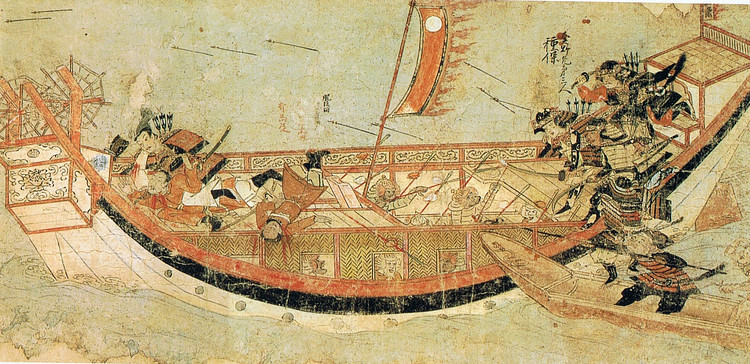
Some sieges could still last for years despite the bombardments, such as that at the Song fortified city of Xiangyang, brought down by battering rams and catapults designed by two Islamic engineers. These static armies also required a much greater logistical support than the traditional cavalry units which were expected to live off the land as best they could until resupplied by trains of carts, packhorses, and camels, which were often managed by Mongol women. Another steep learning curve was how to master naval warfare. By the 1270s CE and the defeat of the Song, the Mongols had command of their own naval fleet which was comprised of 5,000 ships and 70,000 sailors, which were used at sea and on rivers. Massive fleets manned by Chinese and Koreans invaded Japan and Southeast Asia, but these larger ships were really designed for use as troop carriers (they were actually the same as merchant trading vessels) rather than as fighting ships. As ever, the cavalry was supposed to win the day once the expedition was established on dry land.
Decline
The Mongols may have carved out an empire which stretched from the Black Sea to the Korean peninsula but they were not always successful in their campaigns. Some cities did prove too tough to break down and logistical support was an ever-growing problem the further they campaigned away from their heartlands in Mongolia. Both invasions of Japan were foiled by a combination of stiff resistance and storms. The campaigns in Southeast Asia had some success but gave a mixed set of results overall, the Mongols struggling to cope with tropical jungle terrain, heavy rains, diseases, unfamiliar weapons like poisoned darts from blowpipes, war elephants, and effective guerrilla warfare tactics by the enemy. Even in China, they succumbed to the new great power in East Asia: the Ming Dynasty. By 1368 CE, the Mongols were weakened by a series of droughts, famines, and dynastic disputes amongst their own elite. Indeed, one might say that the once-nomadic Mongols were really only defeated by themselves for they had become a part of the sedentary societies they had so long fought against.
